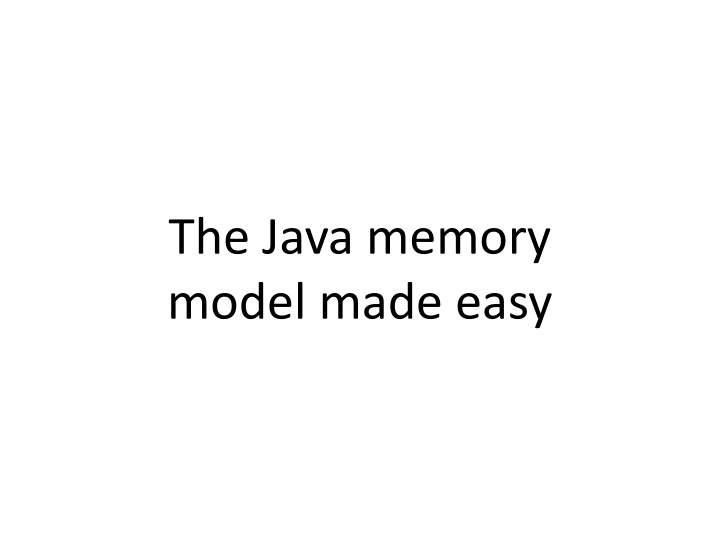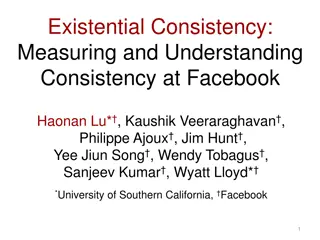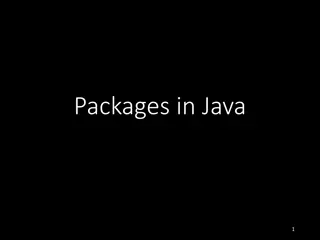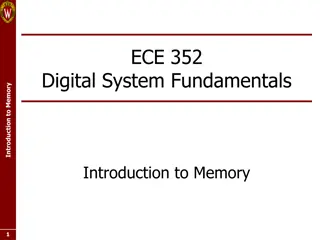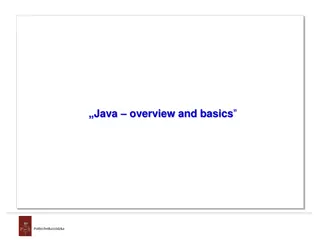Java Memory Model: Execution, Consistency, and Optimization
The Java memory model governs how Java code is executed, emphasizing sequential consistency, main memory interactions, and processor caching. Learn about the complexities of execution, optimizations, and eventual consistency in multi-threaded applications.
Download Presentation

Please find below an Image/Link to download the presentation.
The content on the website is provided AS IS for your information and personal use only. It may not be sold, licensed, or shared on other websites without obtaining consent from the author.If you encounter any issues during the download, it is possible that the publisher has removed the file from their server.
You are allowed to download the files provided on this website for personal or commercial use, subject to the condition that they are used lawfully. All files are the property of their respective owners.
The content on the website is provided AS IS for your information and personal use only. It may not be sold, licensed, or shared on other websites without obtaining consent from the author.
E N D
Presentation Transcript
The Java memory model made easy
How is Java code executed? Java javac processor JVM source code byte code machine code Optimizations are applied almost exclusively after handing responsibility to the JVM s runtime where they are difficult to comprehend. A JVM is allowed to alter the executed program as long as it remains correct. The Java memory model describes a contract for what a correct program is (in the context of multi-threaded applications). The degree of optimization is dependent on the current compilation stage.
Sequential consistency main memory class Reordering { foo == 0 foo == 1 foo == 3 int foo = 0; int bar = 0; bar == 0 bar == 1 void method() { foo += 1; bar += 1; foo += 2; } processor cache } foo == 1 foo == 0 bar == 0 bar == 1 foo == 3
A sequentially inconsistent optimization void method() { foo += 1; bar += 1; (foo == 0, bar == 0) (foo == 1, bar == 0) (foo == 1, bar == 1) (foo == 3, bar == 1) foo += 2; optimization } void method() { foo += 1; foo += 2; (foo == 0, bar == 0) (foo == 1, bar == 0) (foo == 3, bar == 0) (foo == 3, bar == 1) bar += 1; } optimization void method() { foo += 3; (foo == 0, bar == 0) (foo == 3, bar == 0) (foo == 3, bar == 1) bar += 1; }
Scaling performance: cache efficiency does matter action action approximate time (ns) approximate time (ns) typical processor instruction typical processor instruction 1 1 fetch from L1 cache fetch from L1 cache 0.5 0.5 branch misprediction branch misprediction 5 5 fetch from L2 cache fetch from L2 cache 7 7 mutex lock/unlock mutex lock/unlock 25 25 fetch from main memory fetch from main memory 100 100 2 kB via 1 GB/s 2 kB via 1 GB/s 20.000 20.000 seek for new disk location seek for new disk location 8.000.000 8.000.000 read 1 MB sequentially from disk read 1 MB sequentially from disk 20.000.000 20.000.000 Source: https://gist.github.com/jboner/2841832
Eventual consistency main memory flag == true class Caching { boolean flag =true; int count = 0; count == 0 never writes to flag never writes to count void thread1(){ while(flag){ count++; } } processor cache 1 count > 0 void thread2(){ flag =false; } } processor cache 2 flag == false
An eventually inconsistent optimization void thread1(){ while(flag){ count++; } } void thread2(){ flag =false; } optimization optimization void thread1(){ while(true){ count++; } } void thread2(){ // flag = false; } Mnemonic: Think of each thread as if it owned its own heap (infinitive caches).
Atomicity main memory (32 bit) foo/1 = 0x0000 foo/1 = 0xFFFF class WordTearing { long foo = 0L; foo/2 = 0xFFFF foo/2 = 0x0000 void thread1() { foo = 0x0000FFFF; // = 2147483647 } processor cache (32 bit) foo/1 = 0x0000 1 void thread2() { foo = 0xFFFF0000; // = -2147483648 } } foo/2 = 0xFFFF processor cache (32 bit) foo/1 = 0xFFFF 2 foo/2 = 0x0000
Processor optimization: a question of hardware architecture ARM PowerPC SPARC TSO x86 AMD64 load-load yes yes no no no load-store yes yes no no no store-store yes yes no no no store-load yes yes yes yes yes Source: Wikipedia x86 ARM
Mobile devices become increasingly relevant 78% 42% 64% Americans owning a particular device in 2014. Source: Pew Research center
What is the Java memory model? Answers: what values can be observed upon reading from a specific field. Formally specified by disaggregating a Java program into actions and applying several orderings to these actions. If one can derive a so-called happens-before ordering between write actions and a read actions of one field, the Java memory model guarantees that the read returns a particular value. A trivial, single-threaded example: class SingleThreaded { int foo = 0; void method() { foo = 1; assert foo == 1; } write action read action program order } The JMM guarantees intra-thread consistency resembling sequential consistency.
Java memory model building-blocks method-scoped field-scoped final volatile synchronized (method/block) java.util.concurrent.locks.Lock Using the above keywords, a programmer can indicate that a JVM should refrain from optimizations that could otherwise cause concurrency issues. In terms of the Java memory model, the above concepts introduce additional synchronization actions which introduce additional (partial) orders. Without such modifiers, reads and writes might not be ordered (weak memory model) what results in a data race. A memory model is a trade-off between a language s simplicity (consistency/atomicity) and its performance.
Volatile field semantics class DataRace { volatile boolean ready =false; int answer = 0; boolean ready =false; void thread1(){ while(!ready); assert answer == 42; } void thread2(){ answer = 42; ready =true; } } expected execution order
Volatile field semantics: reordering restrictions . . . answer = 42; ready =true; synchronization order program order while(!ready); assert answer == 42; . . . program order happens-before order time 1. When a thread writes to a volatile variable, all of its previous writes are guarantted to be visible to another thread when that thread is reading the same value. 2. Both threads must align their volatile value with that in main memory. 3. If the volatile value was a long or a double value, word-tearing was forbidden. This only applies for two threads with a write-read relationship on the same field! Important: the synchronized keyword also implies an synchronization order. Synchronization order is however not exclusive to it (as demonstrated here)!
Synchronized block semantics class DataRace { boolean ready =false; int answer = 0; synchronized void thread1(){ // might dead-lock! void thread1(){ } while(!ready); assert answer == 42; void thread2(){ synchronized void thread2(){ } } answer = 42; ready =true;
Synchronized block semantics: reordering restrictions . . . <enter this> answer = 42; ready =true; <exit this> program order synchronization order <enter this> while(!ready); assert answer == 42; <exit this> . . . program order happens-before order time This example assumes that the second thread acquires the monitor lock first. When a thread releases a monitor, all of its previous writes are guaranteed to be visible to another thread after that thread is locking the same monitor. This only applies for two threads with a unlock-lock relationship on the same monitor!
Thread life-cycle semantics class ThreadLifeCycle { int foo = 0; void method(){ foo = 42; new Thread(){ @Override public void run(){ assert foo == 42; } }.start(); } }
Thread life-cycle semantics: reordering restrictions . . . foo = 42; new Thread(){ }.start(); program order synchronization order program order <start>; assert foo == 42; . . . happens-before order time When a thread starts another thread, the started thread is guaranteed to see all values that were set by the starting thread. Similarly, a thread that joins another thread is guaranteed to see all values that were set by the joined thread.
Final field semantics class UnsafePublication { class UnsafePublication { final int foo; int foo; int foo; UnsafePublication(){ foo = 42; } } UnsafePublication(){ foo = 42; static UnsafePublication instance; static void thread1(){ instance =new UnsafePublication(); } instance.<init>(); } static UnsafePublication instance; static void thread1(){ instance =<allocate UnsafePublication>; static void thread2(){ if(instance !=null){ assert instance.foo == 42; } } } } } static void thread2(){ if(instance !=null){ assert instance.foo == 42; }
Final field semantics: reordering restrictions . . . constructor instance =<allocate>; instance.foo = 42; <freeze instance.foo> dereference order if(instance !=null){ assert instance.foo == 42; } . . . happens-before order time When a thread creates an instance, the instance s final fields are frozen. The Java memory model requires a field s initial value to be visible in the initialized form to other threads. This requirement also holds for properties that are dereferenced via a final field, even if the field value s properties are not final themselves (memory-chain order). Does not apply for (reflective) changes outside of a constructor / class initializer.
External actions class Externalization { int foo = 0; void method(){ foo = 42; jni(); } program order native void jni(); /* { assert foo == 42; } */ } A JIT-compiler cannot determine the side-effects of a native operation. Therefore, external actions are guaranteed to not be reordered. External actions include JNI, socket communication, file system operations or interaction with the console (non-exclusive list).
Thread-divergence actions class ThreadDivergence { int foo = 42; void thread1(){ while(true); foo = 0; } program order void thread2(){ assert foo == 42; } } Thread-divergence actions are guaranteed to not be reordered. This prevents surprising outcomes of actions that might never be reached.
In practice: recursive final references class Tree { final Leaf leaf; Tree(){ leaf =new Leaf(this); } } class Leaf(){ final Tree tree; Leaf(Tree tree){ this.tree = tree; } } There is nothing wrong with letting a self-reference escape from a constructor. However, the semantics for a final field are only guaranteed for code that is placed after an object s construction. Watch out for outer references of inner classes!
In practice: double-checked locking class DoubleChecked { static DoubleChecked instance; static volatile DoubleChecked instance; static DoubleChecked getInstance(){ if(instance ==null){ synchronized (this){ if(instance ==null){ instance =new DoubleChecked(); } } return instance; } int foo = 0; DoubleChecked(){ foo = 42;} void method(){ assert foo == 42;} } It does work! (This is how Scala implements lazy values.)
In practice: safe initialization and publication Problem: how to publish an instance of a class that does not define its fields to be final? Besides plain synchronization and the double-checked locking idiom, Java offers: 1. Final wrappers: Where double-checked locking requires volatile field access, this access can be avoided by wrapping the published instance in a class that stores the singleton in a final field. 2. Enum holder: By storing a singleton as a field of an enumeration, it is guaranteed to be initialized due to the fact that enumerations guarantee full initialization. x86 ARM 1 thread 8 threads 1 thread 4 threads final wrapper 28.228 28.237 2.256 2.485 enum holder 2.257 2.415 13.523 13.530 double-checked 33.510 29.412 2.256 2.475 synchronized 18.860 302.346 77.560 1291.585 measured in ns/op; continuousinstance requests Source: http://shipilev.net/blog/2014/safe-public-construction/
In practice: atomic access class Atomicity { volatile int foo = 42; volatile int bar = 0; void multiThread(){ while(foo--> 0){ bar++; } assert foo == 0 && bar == 42; } } } class Atomicity { final AtomicInteger foo =new AtomicInteger(42); final AtomicInteger bar =new AtomicInteger(0); void multiThread(){ while(foo.getAndUpdate(x -> Math.max(0, x--))> 0){ bar.incrementAndGet(); } assert foo.get()== 0 && bar.get()== 42; } // foo = foo - 1 // bar = bar + 1 Atomic wrapper types are backed by volatile fields and invoking the class s methods imply the guarantees given by the Java memory model. Only single read and write operations are atomic. In contrast, increments or decrements are not atomic!
In practice: array elements class DataRace { volatile boolean[] ready = new boolean[] { false }; int answer = 0; void thread1() { while (!ready[0]); assert answer == 42; } void thread2() { answer = 42; ready[0] = true; } } Declaring an array to be volatile does not make its elements volatile! In the above example, there is no write-read edge because the array is only read by any thread. For such volatile element access, use java.util.concurrent.atomic.AtomicIntegerArray.
Memory ordering in the wild: Spring beans class SomeBean(){ private Foo foo; private Bar bar; void setFoo(Foo foo){ this.foo = foo; } @PostConstruct void afterConstruction(){ bar =new Bar(); } void method(){ assert foo !=null&& bar !=null; } } An application context stores beans in a volatile field after their full construction, then guarantees that beans are only exposed via reading from this field to induce a restriction.
Memory ordering in the wild: Akka actors class SomeActor extends UntypedActor { int foo = 0; @Override public void onReceive(Object message){ if(message instanceof Foo){ foo = 42; getSelf().tell(new Bar()); }else{ assert foo == 42; } } } Akka does not guarantee that an actor receives its messages by the same thread. Instead, Akka stores and receives its actor references by a volatile field on before and after every message to induce an ordering restriction.
Memory model implementation A Java virtual machine typically implements a stricter form of the Java memory model for pragmatic reasons. For example, the HotSpot virtual machine issues memory barriers after synchronization points. These barriers forbid certain types of memory reordering (load-load, load-store, store-load, store-store). Relying on such implementation details jeopardizes cross-platform compatibility. synchronized (new Object()){ /* empty */ } Always code against the specification, not the implementation!
Memory model validation: the academic approach set of all possible field values program order synchronization order happens-before order commitable The transitive closure of all orders determines the set of legal outcomes. Theory deep dive: "Java Memory Model Pragmatics" by Aleksey Shipil v
Memory model validation: the pragmatic approach @JCStressTest @State class DataRaceTest { Important limitations: 1. Not a unit test. The outcome is non-deterministic. 2. Does not prove correctness, might discover incorrectness. 3. Result is hardware-dependent. boolean ready =false; int answer = 0; @Actor void thread1(IntResult1 r){ while(!ready); r.r1 = answer; } Other tools: Concurrency unit-testing frameworks such as thread-weaver offer the introduction of an explicit execution order for concurrent code. This is achieved by instrumenting a class s code to include explicit break points which cause synchronization. These tools cannot help with the discovery of synchronization errors. @Actor void thread2(){ answer = 42; ready =true; } }
A look into the future: JMM9 In the classic Java memory model, order restrictions of volatile fields were only required for the volatile fields but not for surrounding reads and writes. As a result, the double-checked locking idiom was for example dysfunctional. With the JSR-133 which was implemented for Java 5, today s Java memory model was published with additional restrictions. Due to the additional experience with the revised Java memory model and the evolution of hardware towards 64-bit architectures, another revision of the Java memory model, the JMM9, is planned for a future version. 1. The volatile keyword is overloaded. It is not possible to enforce atomicity without enforcing reorder and caching restrictions. As most of today s hardware is already 64-bit, the JMM9 wants to give atomicity as a general guarantee. 2. It is not possible to make a field both final and volatile. It is therefore not possible to guarantee the visibility of a volatile field after an object s construction. The JMM9 wants to give construction shape visibility as a general guarantee.
Data races When a read and at least one right are not ordered, a Java program is suffering a data race. Even in case of a data race, the JMM guarantees certain constraints. 1. Any field returns at least the field type s default value. A Java virtual machine never exposes garbage values to a user. 2. There is no word-tearing in Java. Apart from long and double values, any field write operation is atomic. 3. The Java memory model forbids circular reasoning (out-of-thin-air values).
http://rafael.codes @rafaelcodes http://documents4j.com https://github.com/documents4j/documents4j http://bytebuddy.net https://github.com/raphw/byte-buddy
